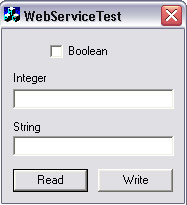Consumer in C++ to read and write PLC variables
This sample explains how to create an ADS-WebService-Consumer to read and write PLC-Variables via ADS-HTTP.
Unzip the sample 'WebServiceTestConsumer (C++)'.
1. Creating a WebService-Consumers within the Microsoft Visual C++
Create a new project with the help of the MFC-AppWizard.
Copy th files 'WebServiceConnector.cpp', 'WebServiceConnector.h', 'Base64.cpp' and 'Base64.h' (can be found in the 'WebServiceSampleCPP.zip'-file) to your project-folder and add them into the project
Insert the following line to the file in which you want to use the ADS Web Service:
#include "WebServiceConnector.h"
Before you can read and write you must create an object of the WebServiceConnector and connect to the WebService:
CWebServiceConnector webServiceConnector;
webServiceConnector.Connect("http://192.168.0.2.1.1/TcAdsWebService/TcAdsWebService.dll");
The address must be the URL of your TwinCAT ADS WebService-DLL-file.
2. Reading PLC -variables
To read a PLC-variable use the "Read"-method of the WebServiceConnector-object:
HRESULT Read(char* netId, int port, ULONG indexGroup, ULONG indexOffset, ULONG* pcbData, BYTE* pData);
- char* netId: String indicating the AMS-Net-Id of the PLC
- int port: Port-number of the Runtime-System
- ULONG indexGroup: IndexGroup of the variables to read
- ULONG indexOffset: First byte to read
- ULONG cblen: Number of bytes to read
- Byte[] pData: Byte-array to save the PLC-data into
- return value: errorcode
The 3 methods
HRESULT ReadInt (char* netId, int port, ULONG indexGroup, ULONG indexOffset, ULONG cblen, int& ret);
HRESULT ReadBool (char* netId, int port, ULONG indexGroup, ULONG indexOffset, ULONG cblen, bool& ret);
HRESULT ReadString (char* netId, int port, ULONG indexGroup, ULONG indexOffset, ULONG cblen, CString& ret);
convert the variables to their corresponding type.
Example:
bool Boolean;
if (webServiceConnector.ReadBool("192.168.0.2.1.1", 801, 16416, 0, 1, Boolean)!=S_OK)
MessageBox("Error");
3. Writing PLC-variables
HRESULT Write(char* netId, int port, ULONG indexGroup, ULONG indexOffset, ULONG cblen, BYTE* pData);
- netId: String indicating the AMS-Net-Id of the PLC
- port: Port-number of the Runtime-System
- indexGroup: IndexGroup of the variable
- indexOffset: First byte to write to
- pData: Byte-array containing the data to write
- return value: errorcode
The 3 methods
HRESULT WriteInt(char* netId, int port, ULONG indexGroup, ULONG indexOffset, ULONG cblen, int Value);
HRESULT WriteBool(char* netId, int port, ULONG indexGroup, ULONG indexOffset, ULONG cblen, bool Value);
HRESULT WriteString(char* netId, int port, ULONG indexGroup, ULONG indexOffset, ULONG cblen, CString Value);
convert the variables to a byte-arrays.
Example:
if (webServiceConnector.WriteBool("192.168.0.2.1.1", 801, 16416, 0, 1, true)!=S_OK)
MessageBox("Error");4. Error codes
S_OK - No error
E_NO_CON - No connetion to the WebService
E_SEND - Unable to send data to the WebService
E_RESPONSE - Unknown response from the WebService
E_FAILED - Unknown error
5. PLC-program, IEC1131 daclaration of the variables:
PROGRAM MAIN
VAR
PlcVarBool AT %MX0.0 : BOOL := TRUE;
PlcVarInt AT %MW1 : INT := 1234;
PlcVarString AT %MD3 : STRING := 'Hello Automation';
END_VAR
6. C++ Application, the layout:

7. The source-code:
void CWebServiceTestConsumerDlg::OnRead()
{
CWebServiceConnector webServiceConnector;
webServiceConnector.Connect(WebServiceURL);
if (webServiceConnector.IsConnected())
{
int Integer;
bool Boolean;
CString String;
int port = 801;
int group = 16416;
unsigned long size;
int offset;
/* read bool */
size = 1;
offset = 0;
if (webServiceConnector.ReadBool(WebServiceNetId,port,group,offset,size,Boolean) == S_OK)
{
m_boolean = Boolean;
}
else
{
MessageBox("Error");
return;
}
/* read int */
size = 2;
offset = 1;
if (webServiceConnector.ReadInt(WebServiceNetId,port,group,offset,size,Integer) == S_OK)
{
m_integer = Integer;
}
else
{
MessageBox("Error");
return;
}
/* read string */
size = 81;
offset = 3;
if (webServiceConnector.ReadString(WebServiceNetId,port,group,offset,size,String) == S_OK)
{
m_string = String;
}
else
{
MessageBox("Error");
return;
}
UpdateData(false);
}
else MessageBox("Error");
}
void CWebServiceTestConsumerDlg::OnWrite()
{
CWebServiceConnector webServiceConnector;
webServiceConnector.Connect(WebServiceURL);
if (webServiceConnector.IsConnected())
{
UpdateData(true);
int port = 801;
int group = 16416;
int offset;
unsigned long size;
/* write boolean */
size = 1;
offset = 0;
bool boolean = false;
if (m_boolean==1)
boolean = true;
if (webServiceConnector.WriteBool(WebServiceNetId,port,group,offset,size,boolean)!=S_OK)
MessageBox("Error");
/* write integer */
size = 2;
offset = 1;
if (webServiceConnector.WriteInt(WebServiceNetId,port,group,offset,size,m_integer)!=S_OK)
MessageBox("Error");
/* write string */
size = 81;
offset = 3;
if (webServiceConnector.WriteString(WebServiceNetId,port,group,offset,size,m_string)!=S_OK)
MessageBox("Error");
}
else MessageBox("Error");
}